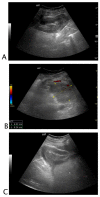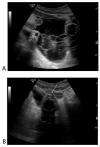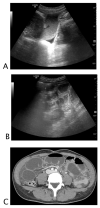The "Black Pattern", a Simplified Ultrasound Approach to Non-Traumatic Abdominal Emergencies
- PMID: 35314643
- PMCID: PMC8938823
- DOI: 10.3390/tomography8020066
The "Black Pattern", a Simplified Ultrasound Approach to Non-Traumatic Abdominal Emergencies
Abstract
Background: A key issue in abdominal US is the assessment of fluid, which is usually anechoic, thus appearing "black". Our approach focuses on searching for fluid in non-traumatic patients, providing a new, simplified method for point-of-care US (POCUS).
Objective: Fluid assessment is based on a three-step analysis that we can thus summarize. 1. Look for black where it should not be. This means searching for effusions or collections. 2. Check if black is too much. This means evaluating anatomical landmarks where fluid should normally be present but may be abnormally abundant. 3. Look for black that is not clearly black. This means evaluating fluid aspects, whether wholly anechoic or not (suggesting heterogeneous or corpusculated fluid).
Discussion: Using this simple method focused on US fluid presence and appearance should help clinicians to make a timely diagnosis. Although our simplified, systematic algorithm of POCUS may identify abnormalities; this usually entails a second-level imaging. An accurate knowledge of the physio-pathological and anatomical ultrasound bases remains essential in applying this algorithm.
Conclusion: The black pattern approach in non -traumatic emergencies may be applied to a broad spectrum of abnormalities. It may represent a valuable aid for emergency physicians, especially if inexperienced, involved in a variety of non-traumatic scenarios. It may also be a simple and effective teaching aid for US beginners.
Keywords: abdomen; abdominal ultrasound; emergency; emergency ultrasound; ultrasound.
Conflict of interest statement
The authors declare no conflict of interest.
Figures










Similar articles
-
Point-of-care ultrasound for acute abdomen: 5W1H (Translated version).J Med Ultrason (2001). 2022 Oct;49(4):609-618. doi: 10.1007/s10396-022-01203-9. Epub 2022 Mar 30. J Med Ultrason (2001). 2022. PMID: 35355123 Review.
-
Usefulness of point-of-care ultrasound for the evaluation of non-traumatic eye emergencies.Med Clin (Barc). 2021 May 21;156(10):503-508. doi: 10.1016/j.medcli.2020.11.031. Epub 2021 Jan 18. Med Clin (Barc). 2021. PMID: 33478811 Review. English, Spanish.
-
[Point-of-Care Abdominal Ultrasound].Rinsho Byori. 2015 Jun;63(6):717-24. Rinsho Byori. 2015. PMID: 26548236 Review. Japanese.
-
Multimodality ultrasound assessment of the spleen: Normal appearances and emergency abnormalities.J Clin Ultrasound. 2023 Mar;51(3):543-559. doi: 10.1002/jcu.23414. Epub 2022 Dec 14. J Clin Ultrasound. 2023. PMID: 36515988 Review.
-
Point-of-care Abdominal Ultrasound.Masui. 2017 May;66(5):503-507. Masui. 2017. PMID: 29693938 English, Japanese.
Cited by
-
Left side jejunal diverticulitis: US and CT imaging findings.Radiol Case Rep. 2024 Apr 20;19(7):2785-2790. doi: 10.1016/j.radcr.2024.04.003. eCollection 2024 Jul. Radiol Case Rep. 2024. PMID: 38680749 Free PMC article.
-
CT prognostic signs of postoperative complications in emergency surgery for acute obstructive colonic cancer.Radiol Med. 2024 Apr;129(4):525-535. doi: 10.1007/s11547-024-01778-y. Epub 2024 Mar 21. Radiol Med. 2024. PMID: 38512630
-
CTA Imaging of Peripheral Arterial Injuries.Diagnostics (Basel). 2024 Jun 26;14(13):1356. doi: 10.3390/diagnostics14131356. Diagnostics (Basel). 2024. PMID: 39001246 Free PMC article. Review.
-
Multimodality Imaging Features of Papillary Renal Cell Carcinoma.Diagnostics (Basel). 2025 Apr 1;15(7):906. doi: 10.3390/diagnostics15070906. Diagnostics (Basel). 2025. PMID: 40218256 Free PMC article.
-
Imaging in Non-Traumatic Emergencies.Tomography. 2023 Jun 12;9(3):1133-1136. doi: 10.3390/tomography9030093. Tomography. 2023. PMID: 37368545 Free PMC article.
References
MeSH terms
LinkOut - more resources
Full Text Sources

